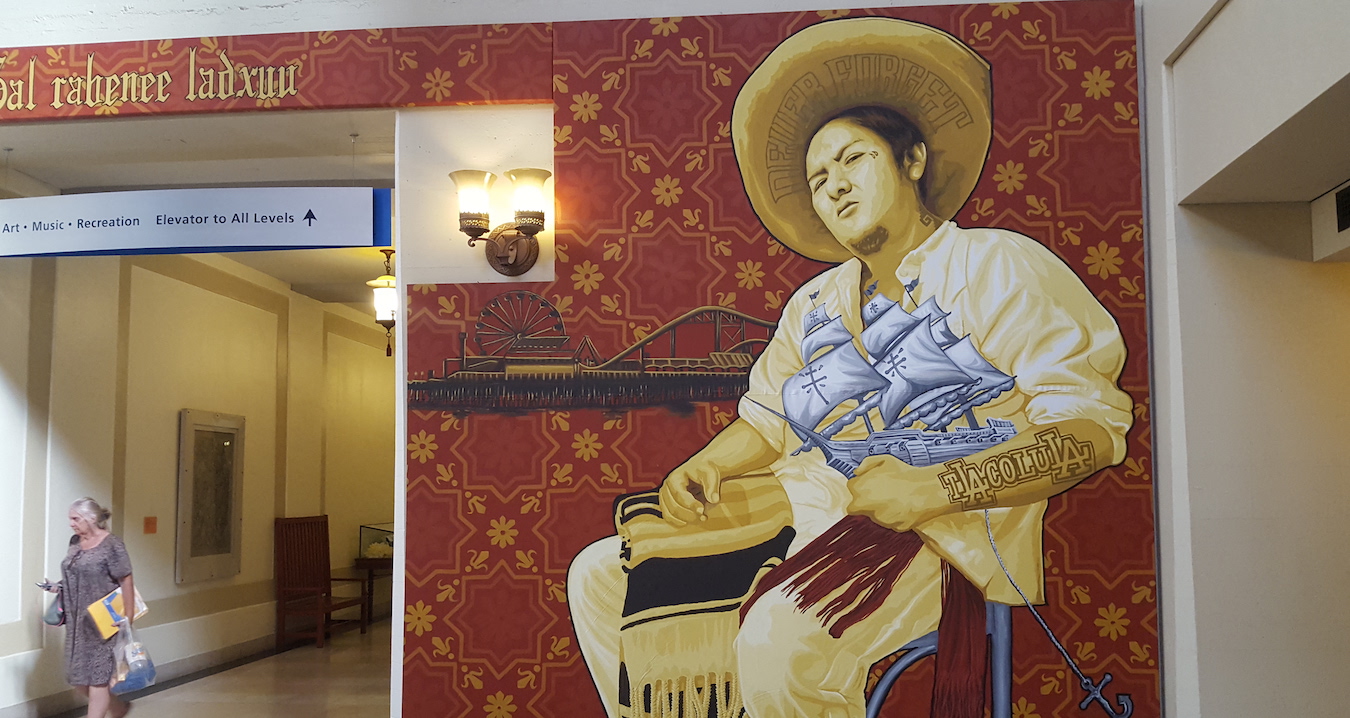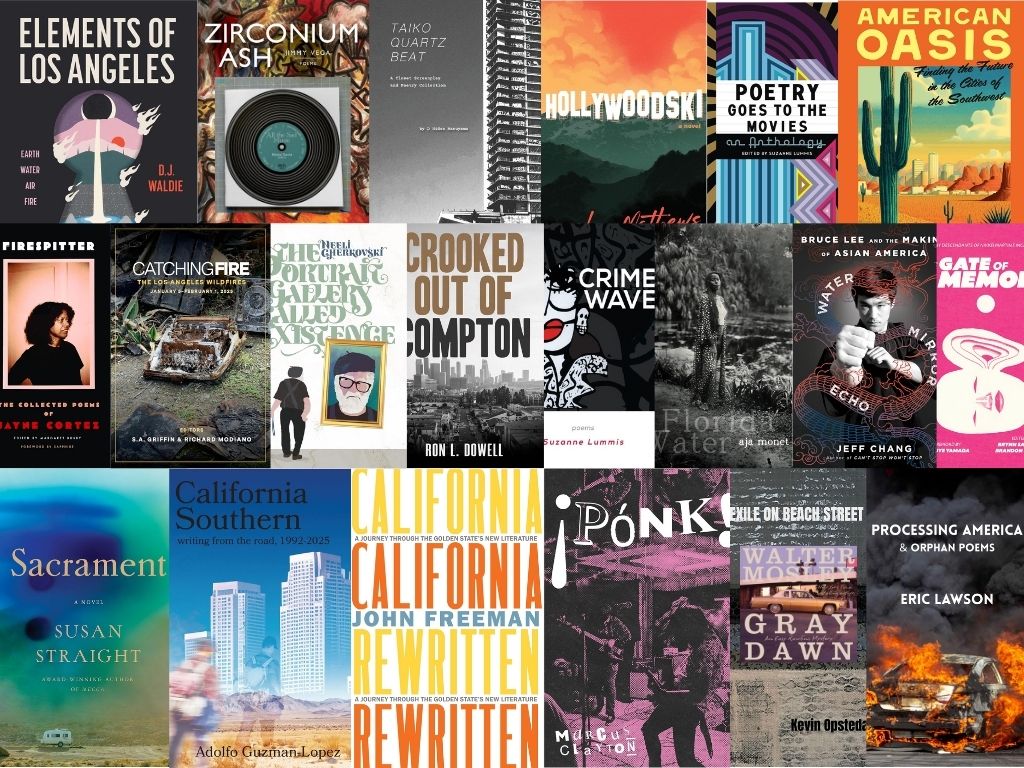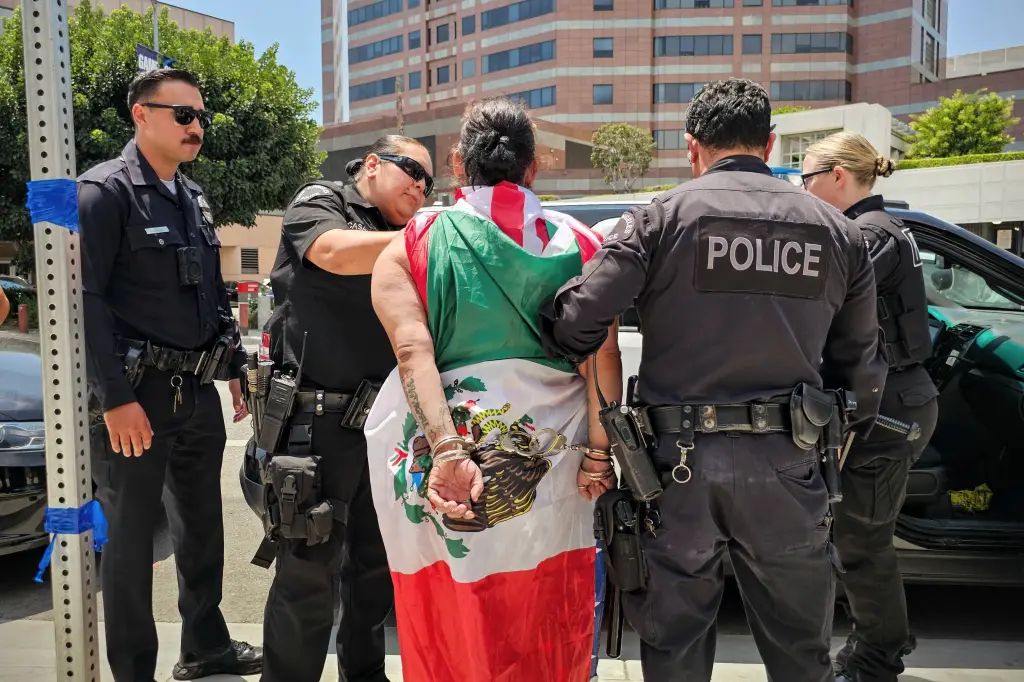[dropcap size=big]O[/dropcap]n Sunday, the Los Angeles Public Library threw a closing party for one of the most celebrated public art installations in L.A. of the last year, the murals created by Oaxacan collective Tlacolulokos in the downtown library’s stately Rotunda.
The exhibit, titled “Visualizing Language,” is an arresting display of murals depicting indigenous immigrant Oaxacans in Los Angeles, showing them as exuberant agents of contemporary American urban life. The themes of the pieces are indigenous empowerment and the culture and identities of transmigration, a counterpoint to the colonialist interpretation of California history as seen in the Rotunda's older murals, by Dean Cornwell.
But the artists who made the Oaxacan murals couldn’t be at the fiesta. That's because they've been temporarily barred from re-entry to the United States.
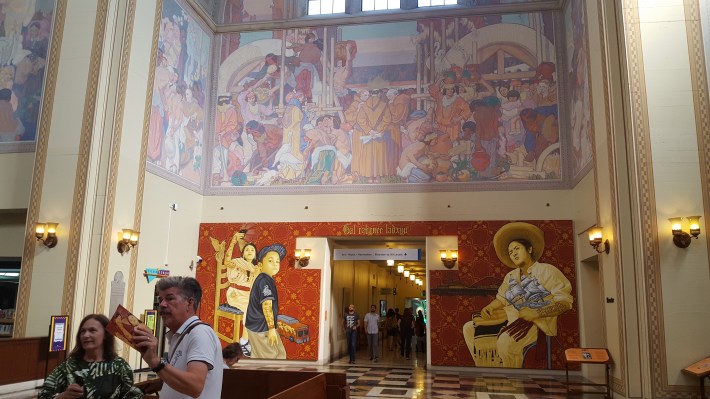
The Tlacolulokos, Dario Canul and Cosijoesa Cernas, had their visas revoked and confiscated by customs agents at San Francisco International Airport on Jan. 8, 2018, the artists said.
They had flown to San Francisco with the typical appointments of working artists with visitor visas in North America: to talk to a business about a commission, and to explore potential projects with galleries and community spaces. But upon meeting customs agents after landing, the Tlacolulokos — indigenous Zapotec men from Tlacolula, Oaxaca, with tattoos, like the figures they depict — were subjected to questioning.
RELATED: No One Who Locks Up Children Should Be Able to Have Dinner at Fancy Mexican Restaurant
In an interview, Canul told L.A. Taco that when asked what they were doing in San Francisco, the artists answered “chamba,” which is Mexican street slang for work or tasks. “They found stuff, the articles, the mention in The New York Times, and well, yes, they saw we weren’t tourists,” Canul said.
Agents detained the men and declared they were misusing their visas, and thus, would be deported. They were flown back to Mexico the next day, after spending a night in detention. “La banda estaba sacada de onda [We were freaked out],” Canul said.
The Tlacolulokos said their visas were revoked for five years.
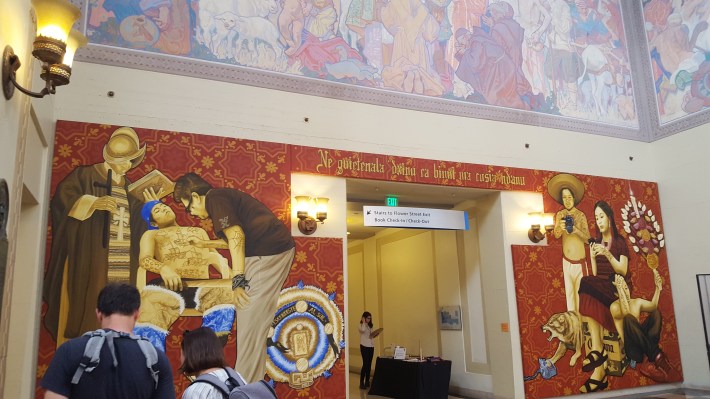
[dropcap size=big]F[/dropcap]or months, the Central Library has not publicly addressed the artists’ deportations or disclosed their case to patrons or press who have covered the “Visualizing Language” exhibit at the Central Library.
Maureen Moore, associate director of ALOUD, said there was nothing the library could do formally to help the artists after federal authorities sent them back to Mexico. While Canul had his visa since 2011, when he did a residency in Fresno, Cernas had acquired his before the ALOUD commission and residency, Canul said. But in January, they were traveling on their own, she said.
“I can’t talk about their San Francisco trip, I don’t have any of the facts,” Moore told me earlier this year. “It’s unfortunate what happened.”
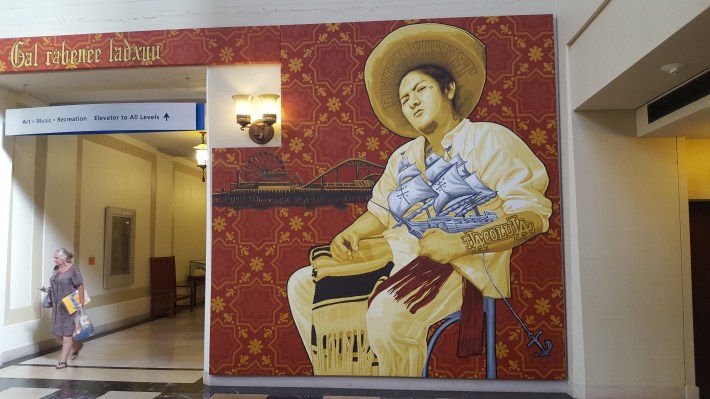
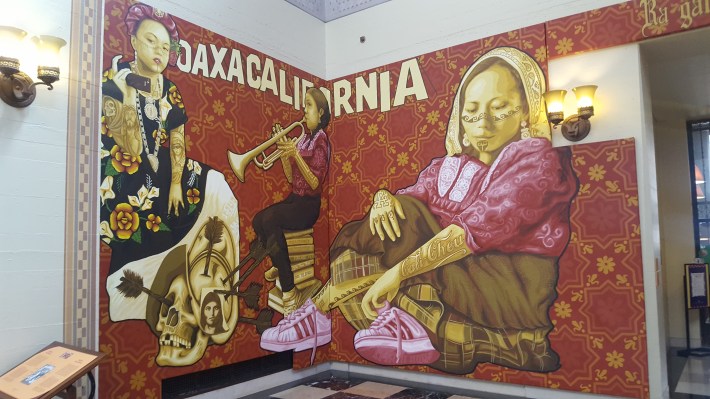
Designers, artists, DJs, musicians, journalists, and promoters travel in and out of the United States on tourism visitor visas, although many are technically working. Of course the practice is forbidden, but like a lot of loopholes and errors in the U.S. immigration system, it’s the status quo.
Xochitl Flores-Marcial, a professor of history at Cal State Northridge, served as a project consultant for the library exhibit with the Tlacolulokos. She is also a native of Tlacolula. She said the fact that the artists do not speak English may have led them to misunderstand the questioning.
“Whoever was the official who quote-unquote ‘interviewed’ them was probably just an asshole, because they didn’t get the proper interpreter to give the words,” Flores-Marcial said.
RELATED: An Ode to Oaxacan L.A. ~ Friday Nights at Poncho's Tlayudas
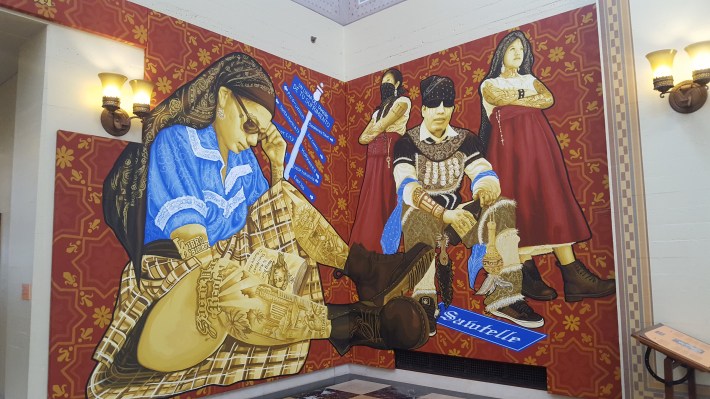
[dropcap size=big]I[/dropcap]n today’s political climate, a few years lost on visas to the U.S. for two guys from Mexico who paint murals might garner little attention, while children and mothers are being subjected to psychological terror at the hands of American immigration authorities who separate them.
But an unintended irony emerges with the case of the Tlacolulokos. An exhibit meant to elevate and affirm the struggles of indigenous immigrants in the United States has neglected to address a situation of potential discrimination and injustice that is directly related to the artwork.
Odilia Romero, a Zapotec interpreter and a friend of the Tlacolulokos, said she reached out to library officials and the Mexican consulate to see what they could do for the artists, but it wasn't enough.
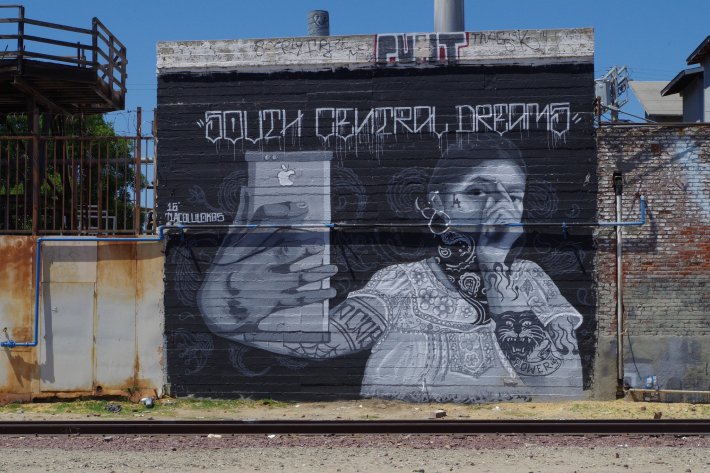
Several high-ranking library authorities also consulted with immigration lawyers to see what they could do for the Tlacolulokos after they were deported, Flores-Marcial said. (Moore said she could not confirm.) “When we found out they were already detained, it was too quick,” Flores-Marcial said.
“Visualizing Language,” which closes in three days, is considered one of the most successful of the dozens of shows that were linked to the gargantuan Pacific Standard Time initiative by the Getty Foundation. Due to the overwhelming positive response to the show, library officials extended its run past its original January 2018 closing date, keeping the murals up through this August 31.
The art was up for nearly a year.
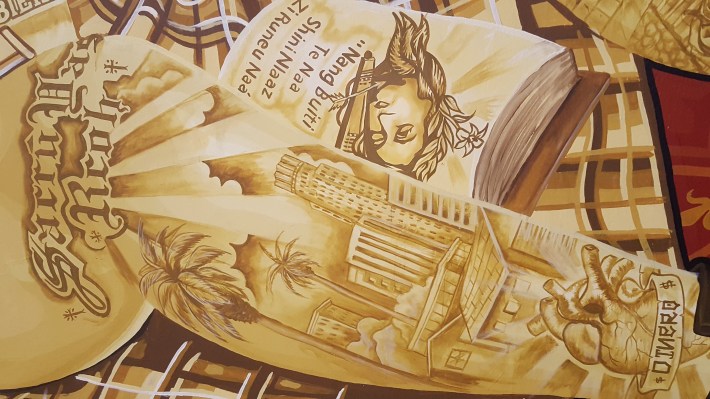
[dropcap size=big]E[/dropcap]ven if you don’t get to catch the show at the Rotunda, there’s a chance you might have come upon a Tlacolulokos piece in Los Angeles recently.
The artists have a highly distinct style. Figures are painted in a yellow-brownish tint, large-scale and realistic. Detailed tattoos and stylistic lettering bring the urban flavor of Los Angeles to the familiar indigenous faces. The collective has left murals in Watts, Pico-Union, and near the abandoned tracks at Slauson and Hoover in South-Central.
Remarkably, the artists are self-taught. Their work makes a convincing case that a visual language exists combining L.A. and Oaxaca that reflects a social, cultural, ethnic, linguistic, and even political migration that cycles back and forth.
“This social migration starts even from when I was born, I received this cultural migration from Los Angeles,” Cernas said during an ALOUD panel discussion on the murals in September 2017, featuring Chaz Bojorquez. “All the characters are real. And we paint them because we feel they have something to say and something to turn over to you today.”
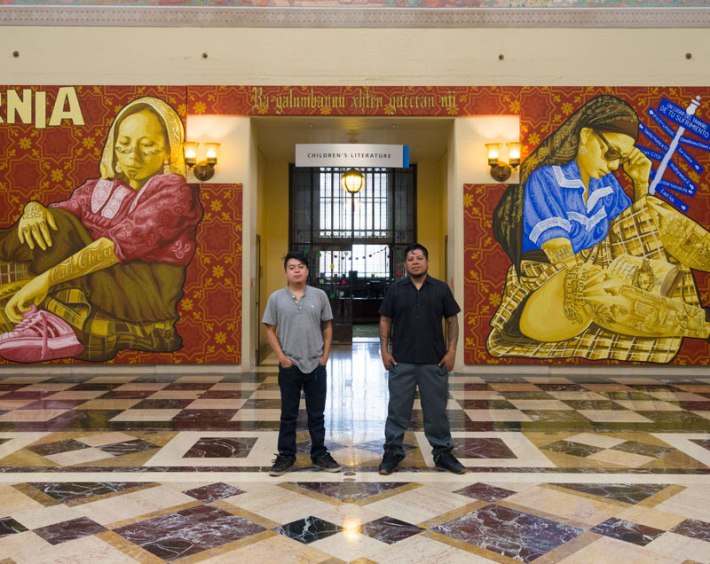
Earlier this month, the library announced that the Tlacolulokos murals will be donated to the Museum of Latin American Art in Long Beach, where they are expected to be exhibited permanently.
Reached in Oaxaca, Canul said he was pleased to hear it. The pieces will also be exhibited briefly in France in the interim. He spoke with a somewhat zen mindset to the whole ordeal with his visa.
“No hay bronca [there’s no beef],” he said in Spanish. “We had this chamba, this chance, but honestly, we don’t have a lot of interest to be over there a lot. … I didn’t really use the visa a lot.”
“We’re not afraid of anyone,” Canul added.
* UPDATE, Wed., 10:00 am: Maureen Moore and ALOUD founder Louise Steinman are no longer with the Library Foundation. No reason for their departure has been stated. "I don't know" if recent exhibit had anything to do with moves, Moore tells us.
